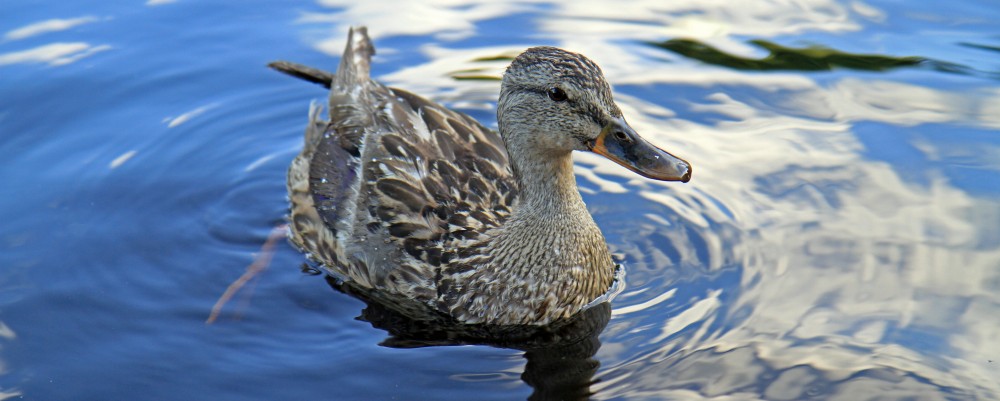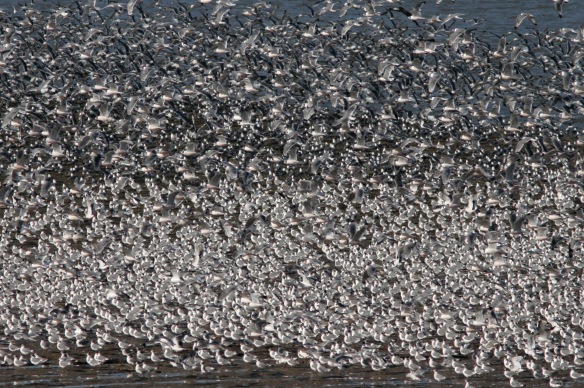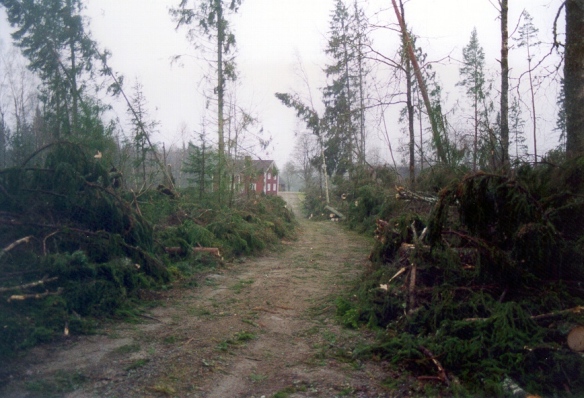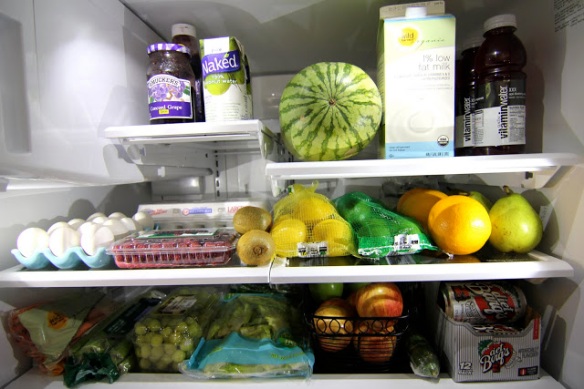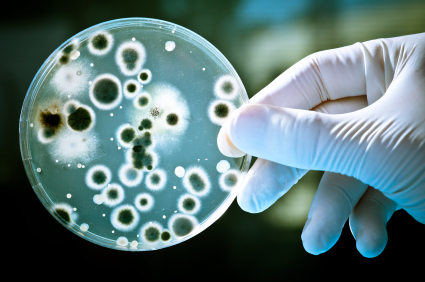
Gulls are our model species for antibiotic resistance dissemination. Picture from Wikimedia Commons.
By Jonas Waldenström
What scare you the most, little one? Is it the monsters under your bed? Warfare, missiles and guns? Climate change? Spiders? Dogs with fangs? Yes, all of them are scary, and most are nasty. But if I have to choose among all the nastiness of this world I’d say antibiotic resistance scares me the most.
You have certainly heard about it, again and again. A researcher, or physician in a white lab coat saying that the situation is “worrisome” or even “alarming”. But it doesn’t really sink in. We don’t want to listen. We hurry, rush the kids to school and daycare, work dull hours in the office and dream about a better life. Or at least considers the substitutes for happiness: a nicer car, a holiday in the sun, or a tight bum. But dreams sift like sand and we settle for a bottle of wine and a piece of beef on a Friday night. We are too occupied to ponder the grander questions, and leave the future for another day.
But if? Think about it.
What if antibiotics didn’t work? What kind of world would that be? We take these drugs for granted, but they are fairy stuff; twinkling wondrous inventions that can be gone in wink, rendered useless by evolution. You see, no one can escape evolution, and we have played the game wrong for as long as we have had antibiotics at our disposal. Instead of safeguarding, we have peppered the bacteria in animals, ourselves and the environment with antibiotics thereby increased the reward for resistance mutations to the point that they rapidly increase in frequency. In our hospitals and stables we have created environments were bacteria could mingle in antibiotic-cladded environments, promoting bacteria to share plasmid-borne resistance markers through horizontal transmission. Bad play, really bad play.
We talk misuse on an epic scale: an ever-accelerated prescription of drugs for any types of infections, even viral infections, where, of course, antibiotics do little good. We have used our drugs on food animals to treat infections, but also as growth promoters in chickens and swine; we have poured bucket loads of antibiotics in ponds to grow shrimps in clear-cut mangrove swamps; we have sprayed antibiotics on apple and fruits to keep them fresh until the retail level. But all this came with a cost, an interest rate we were not considering at the time. And soon it is time to settle the bill, but like Greece we have little means to pay.
When the magic bullets don’t hit their mark we will face a harsh reality. A post-antibiotic world. Science writer Maryn McKenna recently wrote an essay in Medium on how this brave new world would be. A world where simple infections could kill, a return to an era before the two world wars. No more knee implants and hip replacements, no more bowel surgery or nose jobs. A long kiss goodnight on our future health care.
But it can’t be that bad can it, you may ask yourself. They must exaggerate! Clearly, if things were so dire, the Government would do something about it! Well, truth is, we do far too little, governments included. We are standing with one foot leaning over the Pit of Doom (to use Fantasy jargon) and only a concerted action could take us out of it. Simply put, it is tragedy of the commons, where many small decisions end up in a big bad one.
To turn the tiller and set a new course we all need to chip in. Governments need to stimulate research in new drug developments. Global action needs to be taken for how to use antibiotics; these drugs are too potent to be sold over the counter without prescription. And antibiotics should not be used when they are not needed – and farm size and practices need to be addressed in the light of reducing consumption of antibiotics, not in the light of maximizing profit. And there need to be basic science. Our research group addresses the occurrence of resistance in the environment. Using gulls as model species we have travelled wide and far, from pole to pole, and sampled birds for antibiotic resistant bacteria. A few days ago we published our latest article on resistance dissemination in Europe. And it is a scary read.

Antibiotic resistance can attack you when you least expect it. Picture from Wikmedia Commons
A problem in most investigations, especially those conducted on wildlife, is that studies have been small – often a bunch of samples collected without proper sampling design or power calculation. Few studies have addressed larger spatial scales, beyond the country level. Graduate student Johan Stedt set out to change this, and his thesis – that he will defend in June – investigates the occurrence and frequency of resistance markers in gull Escherichia coli on a global scale. In the summer of 2009 (time flies fast in science between fieldwork and published articles) we sent out three teams of trained fieldworkers. In each car there was a liquid nitrogen dewar and sacks of sterile cotton wool swabs. Using our network of ornithologists across Europe, put in place by earlier flu virus studies, we were able to sample gull breeding colonies in nine European countries, from Spain and Portugal in the south, to Scandinavia in the north and the Baltic states in the east. All in all 3152 samples were collected during two weeks of fieldwork. This is by far the largest study conducted in wildlife across Europe.
In the lab, Johan spent months and months going through the samples. First, a primary isolation was done to get putative E. coli isolates. Then the identity of the bacterium needed to be validated with phenotypic test, and then the susceptibility of each isolate was tested with disc diffusion against a panel of 10 antibiotic agents. For the untrained ear they have strange, but beautiful names: ampicillin, cefadroxil, chloramphenicol, nalidixic acid, nitrofurantoin, mecillinam, tetracycline, tigecycline, streptomycin and trimethoprim/sulfamethoxazole. They are, however, commonly used in human and veterinary medicine.
But how is resistance quantified? It is actually rather simple. The isolate is inoculated onto an agar plate where little discs containing antibiotics are attached. The plate goes into a 37C heating cabinet for 24 hours and then one measure how close to the antibiotic discs the bacteria grow. A susceptible bacterium cannot grow close to the disc (where the antibiotic is leaked or ‘diffused’ into the agar), leaving a large zone devoid of growth called the inhibition zone. A resistant bug, on the other hand, can cope with the antibiotic compound and will therefore grow closer to the disc. Resistance is not always a black or white thing. Rather, there is a range of phenotypes with varying susceptibility to a compound. In clinical practice, breakpoints have been established for different bacteria and antibiotics by plotting the range of phenotypes for a large number of samples. This usually gives a normal distribution around the mean for susceptible bacteria, and a hump of isolates as outliers representing the resistant fraction.

Inhibition zones encircle the antibiotic discs in susceptible isolates. Picture from Wikimedia Commons
Let’s return to the gulls. It pretty soon became apparent that resistant bacteria were common and widespread in European gulls. In fact, roughly a third of the isolates retrieved were resistant to at least one antibiotic compound, and a fair proportion was resistant to several. Looking at specific resistance profiles, the most frequently recovered phenotypes were resistant to tetracycline or ampicillin. These results are in concordance with other studies on gulls and may reflect the fact that these antibiotics have been commonly used in both veterinary and human medicine for decades. The occurrence of other resistance phenotypes, such as mecillinam and nalidixic acid resistance, was more surprising. Tigecycline was the only tested antibiotic that we did not find any resistance to; perhaps due to it being a relatively new antibiotic, used for skin-structure infections and complicated intra-abdominal infections.
A striking finding was the geographical variation in resistance levels. Have a look at the map above. Samples from the Iberian Peninsula were on average more often resistant than samples from gulls in more northern countries. This was true for all tested antibiotics (and also for ESBLs, but that is something that will be covered in another publication) and is also mirrored in similar data from humans and food animals in the EU. This south-to-north gradient can have many explanations, but likely reflects true differences in usage of antibiotic compounds across Europe.
Why gulls? What our research has indicated in this and other studies is that gulls are very convenient model species for dissemination of resistant bacteria in the environment. They are everywhere, especially where there is concentration of people, animals, and waste products. The twist in this study was to sample the birds during breeding times, when birds are most sedentary and where results therefore are more likely to depict the local situation.

Finally, what does this tell us? Should we worry about some resistant bugs in gull? The answer is yes, we should. You, me, we all should care – and we should act! Clearly there are no strict boundaries between the everyday lives of humans and the organisms that occur in the environment. The bugs we select for in our hospitals and in agriculture do not stay there – they leak, finding their way out into nature. The gull story shows that similar patterns occur across Europe, the situation in gulls is mirroring the situation in anthropogenic sources. They are our canaries for the antibiotic mines, our whistleblowers. And it is a vivid illustration of the magnitude of the resistance problem we are facing in the future.
Link to the paper:
Stedt, J., Bonnedahl, J., Hernandez, J., McMahon, B.J., Hasan, B., Olsen, B., Drobni, M. & Waldenström, J. 2014. Antibiotic resistance patterns in Escherichia coli from gulls in nine European countries. Infection Ecology and Epidemiology 4: 21565
*******************************************************************************************************************
If you enjoyed this post, or other posts on this blog, why not follow the blog via email, Feedly or get updates via Twitter by following @DrSnygg?

